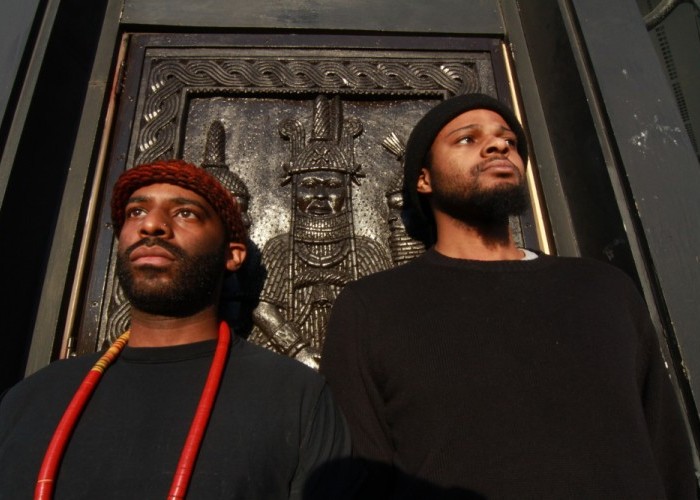Oct 28, 2025 10:47 AM
In Memoriam: Jack DeJohnette, 1942–2025
Jack DeJohnette, a bold and resourceful drummer and NEA Jazz Master who forged a unique vocabulary on the kit over his…

Warren “Trae” Crudup III (left) and Luke Stewart released Blacks’ Myths (Atlantic Rhythms) on June 25.
(Photo: Thomas Sayers Ellis)Luke Stewart has become a ubiquitous presence in Washington, D.C. He plays electric or upright bass in one of nine bands; presents concerts through his efforts with CapitalBop; and hosts a weekly radio show on WPFW Pacifica. Then there’s the steady flow of new music.
The day before the June 25 release of his new disc—Blacks’ Myths (Atlantic Rhythms), a heady yet emotionally transcendental duo offering with drummer Warren “Trae” Crudup III—Stewart anchored a trio led by tenor saxophonist James Brandon Lewis in the city’s Goethe-Institut as part of the D.C. Public Library’s “Jazz in the Basement” concert series. The trio—which also featured Crudup—engaged in scalding, cathartic surges of energy during which Stewart provided as much bristling texture as he did rhythmic momentum and harmonic support.
Stewart’s been a member of Lewis’ trio for four years now; the two met in 2012 at New York City’s Brecht Forum, and connected immediately.
“I always felt like Luke and I were musically brothers from the very beginning; we always understood each other on and off the bandstand,” Lewis said. The saxophonist compares Stewart’s energy and fingering technique to Jimmy Garrison and Fred Hopkins.
On Blacks’ Myths, Stewart and Crudup craft evocative, Afro-futuristic grooves, frequently disrupted by eruptions of feedback dissonance or languid soundscapes. The title alludes to how black people have reinvented themselves in the aftermath of the Mid-Atlantic slave trade.
“Our history has been erased for the most part,” Stewart said. “Black people [in the Americas] don’t have a history, which means that we define ourselves in the unique position of having very little baggage. We can define ourselves in ways that we want to.”
Raised in Ocean Springs, Mississippi, and mostly self-taught as a musician, the 31-year-old Stewart has been reinventing himself in various ways ever since he started playing music down in the Magnolia State. While in middle school, he started playing saxophone, then briefly violin before moving on to the acoustic guitar. A school buddy of his, who also played guitar, was starting a rock band. “He told me to play bass. So, for my birthday, my mom got me a bass guitar. That’s how it happened,” Stewart recalled.
During his time in middle school, while he was playing the saxophone, he and his mother went record shopping. Because of his budding knowledge of John Coltrane, Stewart asked his mother to buy him some Miles Davis recordings. They came across Kind Of Blue and Bitches Brew. He asked his mother which one to get, and she suggested both.
Those records planted the jazz seed. Stewart soon started investigating Chick Corea, Ornette Coleman, Sun Ra and others through vigorous crate digging. He also acquired records from his uncle and grandmother. Stewart, however, was hardly on the straight-and-narrow jazz path. He continued pursuing his interests in rock, punk and hip-hop. When he attended the University of Mississippi in Oxford as an international studies major, he dabbled in turntablism and electronica, too.

Jack DeJohnette boasted a musical resume that was as long as it was fearsome.
Oct 28, 2025 10:47 AM
Jack DeJohnette, a bold and resourceful drummer and NEA Jazz Master who forged a unique vocabulary on the kit over his…

D’Angelo achieved commercial and critical success experimenting with a fusion of jazz, funk, soul, R&B and hip-hop.
Oct 14, 2025 1:47 PM
D’Angelo, a Grammy-winning R&B and neo-soul singer, guitarist and pianist who exerted a profound influence on 21st…

Kandace Springs channeled Shirley Horn’s deliberate phrasing and sublime self-accompaniment during her set at this year’s Pittsburgh International Jazz Festival.
Sep 30, 2025 12:28 PM
Janis Burley, the Pittsburgh International Jazz Festival’s founder and artistic director, did not, as might be…

Jim McNeely’s singular body of work had a profound and lasting influence on many of today’s top jazz composers in the U.S. and in Europe.
Oct 7, 2025 3:40 PM
Pianist Jim McNeely, one of the most distinguished large ensemble jazz composers of his generation, died Sept. 26 at…

Drummond was cherished by generations of mainstream jazz listeners and bandleaders for his authoritative tonal presence, a defining quality of his style most apparent when he played his instrument unamplified.
Nov 4, 2025 11:39 AM
Ray Drummond, a first-call bassist who appeared on hundreds of albums as a sideman for some of the top names in jazz…